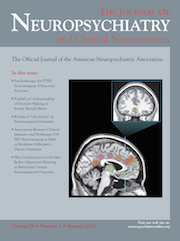To the Editor: Antidepressants have been used in the treatment of chronic pain, including fibromyalgia. However, myalgia induced by antidepressants, including doxepin, trazodone, and mirtazapine, have been reported.
1,2 We report a case of myalgia after treatment with various antidepressants.
Case Report
“Ms. A,” a 41-year-old woman, has received antidepressant treatment for the past 6 years because of her depressed mood and a suicide attempt. Various selective serotonin reuptake inhibitors (SSRI) and serotonin-norepinephrine reuptake inhibitors (SNRI) antidepressants have been used, including fluoxetine, duloxetine, and venlafaxine. During this period, severe myalgia of the calf was noted. It was partially and temporarily reduced by anti-inflammatory drugs. She was later admitted to our psychiatric ward because of depressed mood with suicidal ideation. Before this admission, she did not take any antidepressant for months, and she was under quetiapine, valproic acid, trazodone, clonazepam, and flunitrazepam treatment. Initially, agomelatine at 25 mg/day was given, and was titrated to 50 mg later. At the same time, she was also treated with quetiapine, valproic acid, and clonazepam for impulsivity and severe insomnia. Her depressed mood did not noticeably improve after 18 days of agomelatine treatment; then, the antidepressant was shifted to mirtazapine at 15 mg/day. During that same night, slight myalgia of the calf was noted. On the second day, the myalgia became more severe and disturbed her sleep. After 3 days of treatment, the dosage of mirtazapine was titrated to 30 mg/day. Her myalgia of the calf then increased every night. Later, soreness in the bilateral hips was also reported intermittently. This myalgia could be relieved partially by diclofenac, massages, hot water baths, and posture changes by elevating her legs. There were no sustained muscle contractions, abnormal posture over the lower limbs, or other observed extrapyramidal symptoms while she suffered from the myalgia. The patient did not present any previous history of rheumatologic disease. Neurologic examinations and laboratory data, including that of electrolytes and blood routine, were all within normal limits. Doppler sonography was performed, and showed negative findings in her bilateral femoral vein, popliteal vein, and calf. The mirtazapine was discontinued on the tenth day of treatment. Two days after the discontinuation, the myalgia disappeared. We have tried treatment with doxepin and reusing agomelatine, but myalgia reappeared 1 or 2 days after starting the medications. Because Ms. A’s mood was stabilized under quetiapine medication, she was discharged and will be arranged to undergo psychotherapy.
Discussion
The intensity of the myalgia Ms. A experienced was correlated with the dosage of mirtazapine, and the adverse effect rapidly disappeared after mirtazapine therapy was stopped. The temporal and dosage relationships suggest that myalgia could be an adverse effect of mirtazapine. In our case, myalgia was also caused by other antidepressants, including SSRIs, SNRIs, doxepin, and agomelatine. Our report suggests that antidepressants may cause myalgia, and discontinuation of these agents will rapidly diminish this adverse effect.

